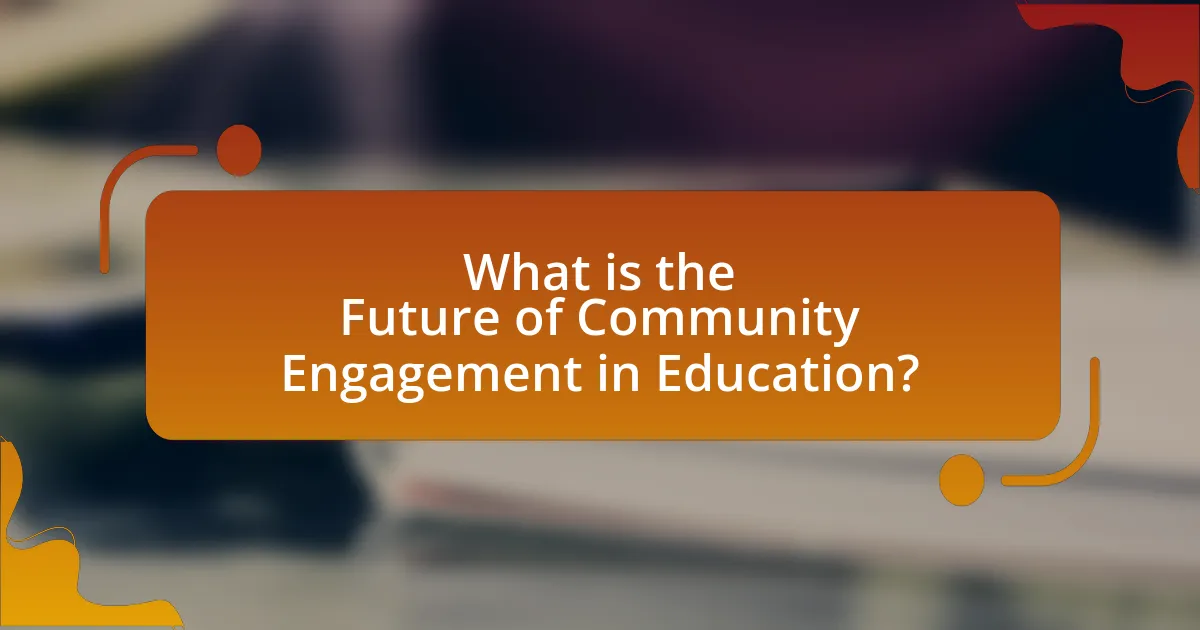The article focuses on the future of community engagement in education, emphasizing the importance of collaborative partnerships among schools, families, and local organizations. It outlines how effective community engagement enhances student learning and well-being, supported by research indicating improved academic outcomes in schools with strong community ties. Key elements of successful engagement include clear communication, active participation, and mutual respect, while trends such as increased technology use and a focus on equity are shaping future practices. The article also discusses the role of educators, the impact of demographic changes, and strategies to overcome barriers to engagement, highlighting the necessity of fostering inclusive and responsive educational environments.

What is the Future of Community Engagement in Education?
The future of community engagement in education will increasingly focus on collaborative partnerships between schools, families, and local organizations. This shift is driven by the recognition that holistic educational experiences enhance student learning and well-being. Research indicates that schools with strong community ties see improved student outcomes; for instance, a study by the Harvard Family Research Project found that students with engaged families are more likely to earn higher grades and have better attendance. Additionally, technology will play a pivotal role, facilitating communication and collaboration through platforms that connect educators with community resources and stakeholders. As educational institutions prioritize inclusivity and responsiveness to community needs, the landscape of community engagement will evolve to foster deeper connections and shared responsibility for student success.
How is community engagement defined in the context of education?
Community engagement in the context of education is defined as the collaboration between educational institutions and community members to enhance learning experiences and address local needs. This collaboration often involves partnerships with families, local organizations, and stakeholders to create a supportive environment for students. Research indicates that effective community engagement can lead to improved student outcomes, increased parental involvement, and stronger community ties, as evidenced by studies showing that schools with active community partnerships report higher student achievement and engagement levels.
What are the key elements of effective community engagement?
The key elements of effective community engagement include clear communication, active participation, mutual respect, and collaboration. Clear communication ensures that all stakeholders understand the goals and processes involved, fostering transparency. Active participation encourages community members to contribute their ideas and feedback, which enhances ownership and investment in the outcomes. Mutual respect builds trust among participants, acknowledging diverse perspectives and experiences. Collaboration involves working together towards common goals, leveraging resources and expertise from various community members. These elements are supported by research indicating that effective community engagement leads to improved educational outcomes and stronger community ties.
How does community engagement differ across various educational settings?
Community engagement varies significantly across educational settings, influenced by factors such as institutional goals, community demographics, and available resources. In K-12 schools, engagement often focuses on parental involvement and local partnerships to enhance student learning, as evidenced by programs like Title I, which aim to improve educational outcomes in low-income areas. In contrast, higher education institutions typically emphasize research collaborations and service-learning initiatives, fostering connections between students and community organizations, as seen in programs like the Campus Compact, which promotes civic engagement in colleges. Additionally, alternative education settings, such as charter schools or community colleges, may prioritize tailored engagement strategies that reflect the unique needs of their student populations, often resulting in more flexible and adaptive approaches to community involvement.
Why is community engagement important for educational institutions?
Community engagement is important for educational institutions because it fosters collaboration between schools and their surrounding communities, enhancing educational outcomes. Engaged communities contribute resources, support, and real-world learning opportunities that enrich the educational experience. Research indicates that schools with strong community ties see improved student performance and higher graduation rates, as evidenced by a study from the National Education Association, which found that students in schools with active community partnerships perform better academically and socially. This collaboration not only benefits students but also strengthens community ties, creating a supportive environment for lifelong learning.
What impact does community engagement have on student outcomes?
Community engagement significantly enhances student outcomes by fostering academic achievement, social skills, and emotional well-being. Research indicates that students involved in community engagement activities demonstrate higher grades, improved attendance, and increased motivation. For instance, a study by the National Education Association found that schools with strong community partnerships saw a 20% increase in student performance on standardized tests. Additionally, community engagement promotes the development of critical social skills, as students learn to collaborate and communicate effectively with diverse groups. This holistic approach not only supports academic success but also contributes to the overall development of students as responsible and engaged citizens.
How does community engagement foster a sense of belonging among students?
Community engagement fosters a sense of belonging among students by creating opportunities for meaningful interactions and shared experiences. When students participate in community activities, they develop connections with peers and local residents, which enhances their social networks. Research indicates that students involved in community service report higher levels of belonging and attachment to their educational institutions, as evidenced by a study published in the Journal of Community Engagement and Scholarship, which found that 85% of participants felt more connected to their school community after engaging in service projects. This sense of belonging is crucial for student retention and academic success, as it promotes a supportive environment where students feel valued and included.
What trends are shaping the future of community engagement in education?
Trends shaping the future of community engagement in education include increased use of technology, a focus on equity and inclusion, and the rise of collaborative partnerships. Technology facilitates real-time communication and resource sharing, enhancing engagement through platforms like social media and online forums. The emphasis on equity and inclusion ensures that diverse voices are represented, fostering a sense of belonging among all community members. Collaborative partnerships between schools, families, and local organizations create a support network that enriches educational experiences. These trends are supported by research indicating that schools with strong community ties see improved student outcomes and higher levels of parental involvement.
How is technology influencing community engagement practices?
Technology is significantly influencing community engagement practices by enhancing communication, accessibility, and participation. Digital platforms such as social media, community apps, and online forums facilitate real-time interaction and feedback between community members and organizations, fostering a more inclusive environment. For instance, a study by the Pew Research Center found that 69% of adults in the U.S. use social media, which serves as a vital tool for mobilizing community initiatives and events. Additionally, technology enables remote participation through virtual meetings and webinars, allowing individuals who may face barriers to physical attendance to engage actively. This shift towards digital engagement not only broadens participation but also strengthens community ties by providing diverse avenues for collaboration and dialogue.
What role do social media platforms play in enhancing community engagement?
Social media platforms significantly enhance community engagement by providing accessible channels for communication and interaction among members. These platforms facilitate real-time discussions, allowing users to share ideas, resources, and feedback, which fosters a sense of belonging and collaboration. For instance, a study by the Pew Research Center found that 69% of adults in the U.S. use social media, highlighting its widespread reach and potential to connect diverse community members. Additionally, social media enables organizations to organize events, share educational content, and mobilize support for initiatives, thereby strengthening community ties and participation.

What predictions can be made about community engagement in education?
Predictions about community engagement in education indicate an increase in collaborative partnerships between schools and local organizations. This trend is supported by research showing that schools that actively involve community stakeholders see improved student outcomes, such as higher graduation rates and enhanced academic performance. For instance, a study by the Harvard Family Research Project found that schools with strong community ties reported a 20% increase in student engagement. Additionally, the rise of digital platforms is expected to facilitate more inclusive and diverse participation from various community members, further enriching the educational experience.
How might community engagement evolve in the next decade?
Community engagement is likely to evolve significantly in the next decade through increased digital integration and a focus on inclusivity. As technology advances, platforms for virtual collaboration will become more prevalent, allowing diverse community members to participate regardless of geographical barriers. For instance, the rise of social media and online forums has already demonstrated how communities can mobilize quickly and effectively, as seen during the COVID-19 pandemic when many organizations shifted to virtual events and discussions. Additionally, educational institutions are increasingly recognizing the importance of involving underrepresented groups in decision-making processes, which aligns with broader societal movements advocating for equity and inclusion. This trend is supported by research from the National Education Association, which highlights that inclusive practices lead to better educational outcomes and community satisfaction.
What emerging models of community engagement are being developed?
Emerging models of community engagement being developed include participatory budgeting, asset-based community development, and digital engagement platforms. Participatory budgeting allows community members to directly influence budget allocations, fostering transparency and accountability in local governance. Asset-based community development focuses on leveraging existing community strengths and resources to drive initiatives, promoting sustainable growth. Digital engagement platforms utilize technology to enhance communication and collaboration among community members, enabling broader participation and inclusivity. These models reflect a shift towards more collaborative and inclusive approaches in community engagement, as evidenced by successful implementations in various cities worldwide, such as Porto Alegre in Brazil for participatory budgeting and numerous localities adopting digital tools for community outreach.
How will demographic changes affect community engagement strategies?
Demographic changes will significantly affect community engagement strategies by necessitating tailored approaches that reflect the diverse needs and preferences of varying population groups. As communities become more multicultural and age-diverse, engagement strategies must adapt to include multiple languages, cultural practices, and age-appropriate methods. For instance, according to the U.S. Census Bureau, the percentage of individuals aged 65 and older is projected to increase from 16% in 2020 to 21% by 2040, indicating a need for strategies that cater to older adults, such as accessible communication and involvement in decision-making processes. Additionally, the growing diversity in racial and ethnic backgrounds requires engagement strategies to incorporate culturally relevant practices, ensuring that all community members feel represented and valued.
What challenges might educational institutions face in fostering community engagement?
Educational institutions may face several challenges in fostering community engagement, including limited resources, lack of awareness, and varying levels of commitment from stakeholders. Limited resources can hinder the ability to organize events or programs that promote engagement, as schools often operate under tight budgets. Additionally, a lack of awareness about the importance of community engagement can lead to insufficient participation from both students and community members. Furthermore, varying levels of commitment from stakeholders, such as faculty, administration, and local organizations, can create inconsistencies in engagement efforts, making it difficult to establish a cohesive strategy. These challenges can significantly impact the effectiveness of community engagement initiatives within educational settings.
How can schools address barriers to effective community engagement?
Schools can address barriers to effective community engagement by implementing inclusive communication strategies and fostering partnerships with local organizations. By utilizing multiple communication channels, such as social media, newsletters, and community meetings, schools can reach diverse audiences and ensure that all community members are informed and invited to participate. Research indicates that schools that actively engage with local organizations, such as nonprofits and businesses, can enhance their outreach efforts and create a supportive network that encourages community involvement. For instance, a study by the National School Public Relations Association found that schools with strong community partnerships reported higher levels of parental involvement and student success, demonstrating the effectiveness of these strategies in overcoming barriers to engagement.
What strategies can be implemented to overcome resistance to community involvement?
To overcome resistance to community involvement, strategies such as building trust, enhancing communication, and providing education about the benefits of participation can be implemented. Building trust involves engaging community members through consistent and transparent interactions, which fosters a sense of belonging and encourages participation. Enhancing communication means utilizing various channels to disseminate information effectively, ensuring that community members are aware of opportunities and the positive impacts of their involvement. Providing education about the benefits of participation can be achieved through workshops and informational sessions that highlight successful case studies, demonstrating how community involvement leads to improved educational outcomes and stronger community ties. These strategies are supported by research indicating that trust and effective communication significantly increase community engagement levels.

How can educational institutions enhance community engagement?
Educational institutions can enhance community engagement by establishing partnerships with local organizations and businesses. These collaborations can lead to joint programs that address community needs, such as service-learning initiatives, internships, and workshops. For instance, a study by the American Association of Colleges and Universities found that institutions that actively engage with their communities report higher student satisfaction and improved academic outcomes. By integrating community service into the curriculum, educational institutions not only foster civic responsibility among students but also strengthen ties with the community, creating a mutually beneficial relationship.
What best practices should be adopted for effective community engagement?
Effective community engagement requires establishing clear communication channels, fostering inclusivity, and building trust. Clear communication ensures that community members are informed and can participate meaningfully, while inclusivity allows diverse voices to be heard, enhancing the richness of the engagement process. Building trust is essential for encouraging ongoing participation and collaboration. Research indicates that communities with strong trust levels are more likely to engage actively in educational initiatives, as seen in studies by the National Education Association, which highlight the correlation between trust and community involvement in schools.
How can partnerships with local organizations strengthen community ties?
Partnerships with local organizations can strengthen community ties by fostering collaboration and resource sharing that directly benefits residents. These partnerships often lead to joint initiatives, such as educational programs or community events, which enhance social cohesion and create a sense of belonging among community members. For instance, research from the National Civic League indicates that communities with active local partnerships experience increased civic engagement and improved trust among residents. This collaborative approach not only addresses local needs more effectively but also empowers individuals by involving them in decision-making processes, thereby reinforcing community bonds.
What role do educators play in facilitating community engagement?
Educators play a crucial role in facilitating community engagement by acting as bridges between schools and local communities. They foster relationships that encourage collaboration on educational initiatives, promote civic responsibility, and enhance student learning through real-world experiences. Research indicates that when educators actively involve community members in school activities, such as service projects or local partnerships, it leads to improved student outcomes and stronger community ties. For instance, a study by the National Education Association found that schools with strong community engagement programs see a 20% increase in student achievement. This demonstrates that educators not only enhance educational experiences but also contribute to the overall vitality of the community.
What resources are available to support community engagement initiatives?
Various resources are available to support community engagement initiatives, including funding opportunities, training programs, and collaborative platforms. Funding sources such as grants from government agencies, foundations, and nonprofit organizations provide financial support for community projects. Training programs offered by educational institutions and community organizations equip individuals with skills in facilitation, communication, and project management, enhancing their ability to engage effectively with the community. Collaborative platforms, such as online forums and social media, facilitate communication and partnership among stakeholders, allowing for the sharing of best practices and resources. These resources collectively empower communities to foster engagement and participation in educational initiatives.
How can funding opportunities be leveraged for community engagement projects?
Funding opportunities can be leveraged for community engagement projects by aligning project goals with the priorities of funding organizations. This alignment increases the likelihood of securing financial support, as funders often seek to invest in initiatives that demonstrate community impact and sustainability. For instance, the National Endowment for the Arts provides grants specifically for projects that foster community participation in the arts, highlighting the importance of community engagement in their funding criteria. By clearly articulating how a project addresses community needs and aligns with funder objectives, organizations can enhance their proposals, thereby increasing funding success rates.
What tools and platforms can assist in managing community engagement efforts?
Tools and platforms that assist in managing community engagement efforts include social media platforms, community management software, and collaboration tools. Social media platforms like Facebook and Twitter facilitate real-time communication and outreach, allowing organizations to connect with community members effectively. Community management software, such as Mobilize and Hivebrite, provides features for organizing events, managing memberships, and tracking engagement metrics. Collaboration tools like Slack and Microsoft Teams enhance communication and project management among community members, fostering a collaborative environment. These tools are essential for streamlining engagement efforts and ensuring effective interaction within educational communities.
What practical steps can educators take to improve community engagement?
Educators can improve community engagement by establishing partnerships with local organizations and businesses. These partnerships can facilitate resource sharing, provide real-world learning opportunities, and enhance student involvement in community projects. For instance, a study by the National Education Association found that schools collaborating with community organizations saw a 20% increase in student participation in extracurricular activities, demonstrating the effectiveness of such partnerships in fostering engagement. Additionally, hosting community events and forums allows educators to gather input from families and local stakeholders, ensuring that educational initiatives align with community needs and interests.


